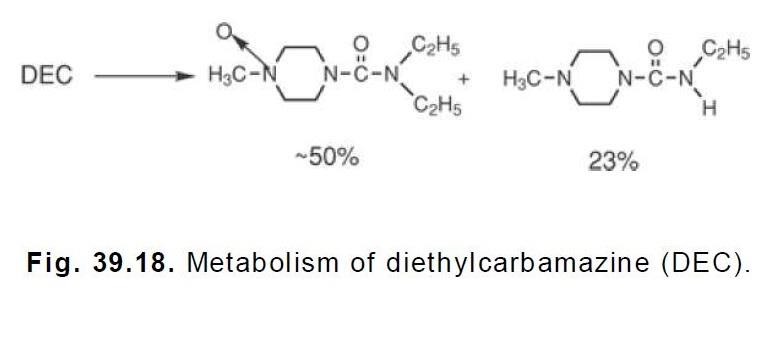N,N-Diethyl-4-methyl-1-piperazincarboxamid Chemische Eigenschaften,Einsatz,Produktion Methoden
Beschreibung
Discovered in the 1940s, diethylcarbamazine (DEC) has proven to be especially effective as a
filaricidal agent. The incidence of filariasis among American troops during World War II
necessitated a search for drugs with an antifalarial spectrum of activity. The once-popular
piperazine also was discovered during these initial screenings. Although chemically similar, the
activity again helminths is quite different. Piperazine is active against nematodes, whereas DEC is
active against falaria and microfalaria.
Indications
Diethylcarbamazine citrate (Hetrazan) is active against
several microfilaria and adult filarial worms. It interferes
with the metabolism of arachidonic acid and
blocks the production of prostaglandins, resulting in
capillary vasoconstriction and impairment of the passage
of the microfilaria. Diethylcarbamazine also increases
the adherence of microfilariae to the vascular
wall, platelets, and granulocytes.
Diethylcarbamazine is absorbed from the gastrointestinal
tract, and peak blood levels are obtained in 4
hours; the drug disappears from the blood within 48
hours. The intact drug and its metabolites are excreted
in the urine.
Diethylcarbamazine is the drug of choice for certain
filarial infections, such as Wuchereria bancrofti, Brugia
malayi and Loa loa. Since diethylcarbamazine is not
universally active against filarial infections, a specific diagnosis
based on blood smears, biopsy samples, and a
geographic history is important. Dosage should be adjusted
in patients with renal impairment.
Caution is necessary when using this agent, particularly
when treating onchocerciasis.The sudden death of
the microfilariae can produce mild to severe reactions
within hours of drug administration. These are manifested
by fever, lymphadenopathy, cutaneous swelling,
leukocytosis, and intensification of any preexisting
eosinophilia, edema, rashes, tachycardia, and headache.
If microfilariae are present in the eye, further ocular
damage may result. Other side effects are relatively
mild and range from malaise, headache, and arthralgias
to gastrointestinal symptoms.
Antimicrobial activity
Useful activity is restricted to filarial worms. It is adulticidal
and microfilaricidal against Loa loa. Against Wuchereria bancrofti
and Brugia malayi it is predominantly microfilaricidal,
but slowly kills adult worms. It kills microfilariae, but not
adults, of Onchocerca volvulus.
Pharmazeutische Anwendungen
A carbamyl derivative of piperazine formulated as the citrate.
It is readily soluble in water and slightly hygroscopic.
Mechanism of action
Although studied extensively, the mechanism of action of DEC remains unknown.
Diethylcarbamazine appears to be the active form of the drug, with a very rapid onset of action
(within minutes), but of interest is the fact that the drug is inactive in vitro, suggesting that
activation of a cellular component is essential to the filaricidal action. Three mechanisms have
been suggested. The first is involvement of blood platelets triggered by the action of filarial
excretory antigens. A complex reaction is thought to occur between the drug, the antigen, and
platelets. Although these authors were unable to show a direct action of the drug on the
microfalaria, a more recent study showed that DEC produced morphological damage to the
microfalaria. The damage consisted of the loss of the cellular sheath, exposing antigenic
determinants to immune defense mechanisms. Severe damage then occurred to microfalaria
organelles, leading to death. The second is inhibition of microtubule polymerization and
disruption of preformed microtubules. The third is interference with arachidonic acid
metabolism. Diethylcarbamazine is known to have anti-inflammatory action, which appears to
involve blockage at cyclooxygenase and leukotriene A4 synthase (leukotriene synthesis). This
action appears to alter vascular and cellular adhesiveness and cell activation. This latter action
would suggest a possible relationship between the first and third mechanism.
Pharmakokinetik
Oral absorption: >90%
C
max 200 mg: 1.5–2 mg/L after 2 h
Plasma half-life: c. 6–12 h
Volume of distribution: 107–371 L
Plasma protein binding: Very low
Like piperazine (to which it is related), diethylcarbamazine
is rapidly and completely absorbed. About half the dose is
excreted unchanged in the urine; the rest is metabolized and
eliminated by renal and extrarenal routes.
Clinical Use
Filariasis
It has also been used for visceral larva migrans, but experience
is limited and there is little evidence of its efficacy.
Nebenwirkungen
In uninfected people, diethylcarbamazine has virtually no
side effects, but in those with various forms of filariasis it
has unpleasant effects primarily due to the death of bloodor
skin-dwelling microfilariae. Severe reactions (‘Mazzotti
reactions’), most frequently of the skin, occur in patients
with onchocerciasis and may also be systemic with fever,
headache, prostration, nausea, joint and muscle pain, vertigo,
tachycardia, cough and respiratory distress, hypotension
and ocular signs. In patients with L. loa who harbor
very large numbers of microfilariae in their blood, neurological
problems may be very severe. Cardiological damage
has also been reported. In patients with W. bancrofti and
B. malayi high fever occurs in the first few days after treatment.
Reversible proteinuria may occur.
Sicherheitsprofil
Poison by
intraperitoneal route. Human systemic
effects by ingestion: allergc dermatitis. An
experimental teratogen. Mutation data
reported. When heated to decomposition it
emits toxic fumes of NOx and HCl. An
additive permitted in the food and drinking
water of animals and/or for the treatment of
food-producing animals.
Stoffwechsel
The metabolism of DEC leads to the compounds shown in Figure 39.18 plus trace amounts of
methylpiperazine and piperazine. Nearly all of the metabolites appear in the urine. As much as 10
to 20% of the drug is excreted unchanged. As indicated by the rapid action of the drug, it would
appear that none of the metabolites are involved in the therapeutic action of DEC.

N,N-Diethyl-4-methyl-1-piperazincarboxamid Upstream-Materialien And Downstream Produkte
Upstream-Materialien
Downstream Produkte

